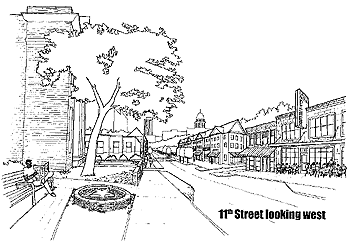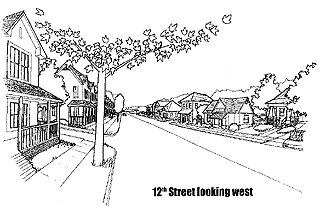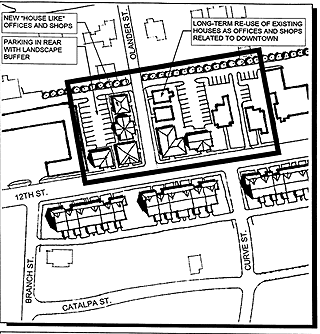https://www.austinchronicle.com/news/1998-10-16/520446/
New Urban Sagas
Mueller Mutation
By Mike Clark-Madison, October 16, 1998, News
Yet for all that, the New Mueller still seems to be -- as we headlined one of my early treatises on the topic -- "Flying Under Radar." This is partly due to the absence-so-far of blood in the streets, and partly it's the typical Eastside story, the reflex of a town that's been trained for years to see East Austin as a vast, one-dimensional, alien ghetto from highway to horizon. But it also bears witness that "Corner to Corner"'s mission is far from accomplished; Mueller is still a "neighborhood issue" without relevance to others citywide.
Already, the jargon of neighbor-speak has been brought into play: The "Mueller neighborhoods" have become a distinct entity (like the "Triangle neighborhoods"), with "concerns" that must be "addressed" by the New Mueller's planners and overseers. Are there concerns? Of course. Are they simply our concerns, visible only from our doorsteps and insignificant to the city at large? Of course not.
The new neighborhood rhetoric makes little distinction between the renovation of a single Walgreens and the redevelopment of an entire ZIP code, and most of what we call "neighborhood concerns" arise around the Walgreens: Traffic, drainage, compatibility with adjacent uses, property values, you know the list. Surely, for neighborhoods like Windsor Park, Pecan Springs, J.J. Seabrook, and Cherrywood -- respectively due north, east, south, and west of the airport -- those direct-impact issues make up part of their "concerns" about the New Mueller. But only part.
My own neighborhood, Swede Hill, lies directly across I-35 from the Erwin Center, and is thus at quite some remove from the airport fence. But we lie smack in between the Capitol Complex and the New Mueller -- where, as you may remember, 282 redeveloped acres will be devoted to State of Texas offices and their paraphernalia. That means a lot of people will pass our doors on their journeys from one state enclave to the other. It also means that many thousands of state workers and visitors will be heading up and down I-35 -- which is basically our residential collector street -- since the state's portion of the New Mueller, along the 51st Street side across from Windsor Park, was chosen largely for its easy access to the highway. So we have become a "Mueller neighborhood," and by proxy have been representing all of Central East Austin in the Mueller planning process.
To their credit, both Roma Design Group and STG/
Partners, the planners engaged respectively by city and state to work out the New Mueller, have been amply responsive to the Mueller neighborhoods and their "concerns," and the current New Mueller plan -- which, though still officially a draft, is damn close to being finalized -- is a welcome surprise given the circumstances. It's not the NewUrb beau ideal, but it's about as progressive as one could realistically expect a state-anchored project to be.
The plan features the de rigeur "town center," mixing state and private-sector commercial spaces, basically due east of the I-35/Airport intersection; larger-scale "urban campus" projects near the perimeter, mostly state-built but with the prime I-35/51st Street corner reserved for a city-controlled "economic generator"; and the balance filled with "row house" and "yard house" residential and lots of green spaces. The state portion is also, sadly, filled with lots of surface parking, though intended to be prettier than your average parking lot, but the state's planners want the site to eventually rely on structured parking if the Texas Legislature ponies up the money.
The planners' official New Mueller vision is consistent with, and largely inspired by, plans and ideas developed by the Mueller neighborhoods themselves over the last 15 years of Move-It fervor, which brings us back to our original point. From the get-go, East Austinites' "concerns" have not just involved the New Mueller's appeal as our neighbor, but its power to redefine our neighborhoods' role within the entire city, and in doing so redefine the city itself. It was the neighbors, not the planners (though the groups do overlap somewhat), who called for a truly urban development that would bring life and opportunity to all of Central and East Austin, and who insisted that it be planned in a way that would make it viable as a business proposition.
Roma and STG have done a splendid job of making that possible inside the Mueller fence. We still have no clue as to what will happen outside the fence, and many Eastsiders, Swede Hill included, are more "concerned" about the wholesale, unplanned transformation of the districts lying in between the carefully planned projects at the New Mueller, or along the Waller Creek Corridor, or on11th and 12th Streets, projects that surround my neighborhood like -- if you will -- a triangle.
Visualizing ARA
|
|
East 11th and 12th Streets are being redeveloped under the aegis of the once-controversial, now fairly anodyne Austin Revitalization Authority. After we Best-of-Austined the ARA a few weeks back as "Most Improved Community Project," I got e-mail from one of the facilitators of the aggrieved Inner Eastside neighbors' failed mediation with the intransigent ARA, a little over a year ago. Having been out of the loop for a while, she said, she was "shocked" that the two sides could and did reach some sort of accord.
Well, not exactly. You may remember that, having failed to subtly convey to most of the Eric Mitchell lackeys on the ARA board that their jig was up, the City Council had to bluntly open the ARA up to all comers, leading to a 32-member board, of whom about half show up on any regular basis. That would be the "neighborhood" half.
The fixers and users who were hanging out with the ARA before, including some of its powerful officers, have seemingly abandoned the project now that they can't dominate it. So the lamb is actually lying down in the lion's place. (This does not include either ARA chairman Dr. Charles Urdy, Mitchell's predecessor on City Council, or interim executive director Byron Marshall; both have shown ample interest in finally getting the ARA mission accomplished, under whatever mandate.) And whaddya know. We now have a plan that does not destroy the Inner Eastside under the guise of revitalization.
"New Visions of Central East Austin," the plan produced for the ARA by Atlanta-based Crane Urban Design Team, is actually a double-edged instrument, both a broad conceptual neighborhood plan for the Inner Eastside between Seventh and MLK (divided into 11 sub-areas) and a specific redevelopment action plan for 11th and 12th Streets. The latter includes 22 separate projects, none of which is a behemoth shopping mall, a 10-story building, or a fast-food restaurant with a parking lagoon. Instead, we see the magic words "urban village" used in connection with 11th Street, and an even more magical phrase -- "planned to maintain much of its existing character" -- pertaining to 12th Street. We see recognition that the Inner Eastside is the supposedly nonexistent affordable downtown residential neighborhood, with repeated attentions in the plan to both preserving our existing housing and adding new projects (including a downtown mixed-use complex, not wholly unlike the latest vision for the Triangle, on the Bennett Properties tract once slated for the shipwrecked East Side Mall).
|
|
And we see this: "Ultimately, the most critical factor in the success of this plan will be the Central East Austin community itself." Couldn't have said it better ourselves, though we did say it, over and over for months, to an ARA which responded by Clintonizing the word "community" to mean something other than "the people who live here." Without the neighbors' buy-in, this will not happen. We now have something worth buying into that, as with the New Mueller, does not simply address our "concerns," but speaks to a vision for Central and East Austin that we share and that ultimately benefits everyone in town.
Many ARA stalwarts will argue, and have argued, that the neighbors are a bunch of hysterics, that the project was always sensitive to the community, and on and on. Really, now. Just before the ARA coup d'etat, the authority put out a newsletter detailing three broad conceptual frameworks -- Alternatives A, B, and C -- that the Crane team had supposedly developed in response to community input (a contention of which I am frankly dubious), one of which would be chosen for further refinement.
Alternative C was the urban-village stuff we now have and for which we've always advocated. But Alternative A was a major regional shopping mall, beyond even the Bennett project in its scope, and Alternative B was a bunch of mid-size office buildings and strip malls. Whoever in the "community" felt that A and B were legitimate, viable responses to Austin's needs, rather than cheap and easy ways to make the Eastside safe for lazy real-estate developers, does not live here and does not know anyone who does. 'Nuff said.
|
|
That's not to say that the Crane plan, which more so than the New Mueller plans is a fluid draft document, is without troubling questions. Some Eastside constituencies, notably Ebenezer Baptist Church, liked the East Side Mall (because they had cut a deal with Bennett Properties, not because they've always dreamed of a shopping mall in the neighborhood), and are not happy with its removal.
As for my own personal perspective, one of the projects slated for Swede Hill itself involves the creation of "house-like" offices and the conversion of existing houses into offices. This is fine here and there, but we've been told for years that one day our whole neighborhood would turn into a boutique district à la the Inner West side, and anything that appears to hasten that day will produce a wee bit of static.
On both 11th Street and the airport runways, the implementation process is bound to be complex, and these sagas are far from over. But we may have the beginnings of a model here: When the planners ask the neighbors, and let themselves be guided by what the neighbors want, the result is often not just good for the neighbors, but good for the entire city. It doesn't always happen that way, but perhaps it could some day. A fine note on which to celebrate this little column's birthday.
Copyright © 2024 Austin Chronicle Corporation. All rights reserved.



